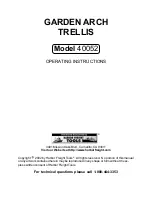
30
Comprehensive audio metering is provided by eight LED bargraph meters.
There are a pair of input meters (labelled A and B for audio channels A and B respectively),
which show the input level immediately following the input gain control. These can therefore
be used as a guide for setting the input gain to match the signal level being sent to the unit.
With the input gain control set to 0dB (unity gain) then full-scale on the meter will occur at a
signal level of +21dBu (which is the maximum permissible signal level). The input meters
incorporate a red ‘clip’ LED that indicates signal clipping both on the actual input to the unit
and also after the gain control - this ensures that all possible clip conditions are monitored
irrespective of the setting of the gain control.
There are a pair of output meters (labelled A and B for audio channels A and B respectively),
which show the output level from the unit. Full-scale on the meter indicates maximum output
from the unit, which corresponds to +21dBu. The output meters also incorporate a red ‘clip’
LED. This indicates signal clipping within the unit, and is monitored at all internal points
where gain can be applied. Thus, if a large amount of gain is added with one section of a
parametric EQ resulting in a clipped signal, but the level is then reduced by a subsequent EQ
section, the clip LED will still light to indicate the internal clip condition despite the
apparently safe output level. In this situation the input gain should be reduced to provide
sufficient headroom for the desired EQ characteristic. Note that because these meters are on
the output of the unit, they will show the effect of any delay that has been selected.
There are four meters which show the action of the
dual - threshold dynamic EQ
system - one meter for each EQ section on each of the two audio channels A and B. The
dynamic EQ meters are calibrated in percentage terms, from 0 to 100. If no dynamic EQ is
selected, or if the signal is below the ‘low’ threshold, then the meters will show 0% (i.e. no
LEDs lit). Under this condition the dynamic EQ will be using the ‘low’ frequency response
settings. If the signal level is above the ‘high’ threshold, the relevant meter will indicate 100%
(fully lit) showing that the ‘high’ EQ settings are now being applied. If the signal is between
the two thresholds, then the EQ will be morphing between the two EQ settings, and the meter
indicates the signal level relative to the two thresholds. Note that the effect of the attack and
release controls is also indicated on these meters - the height of the bar indicates the actual EQ
being applied, so if a slow release is set, for example, you will see the meter drop back slowly
following a peak.
l
abc
Operation DN9340:
Metering
T-DEQ
Содержание HELIX SYSTEM DN9340
Страница 2: ......
Страница 4: ......
Страница 6: ......
Страница 8: ...l abc...
Страница 10: ...2 l abc...
Страница 12: ...4 l abc...
Страница 16: ...l abc 8...
Страница 22: ...l abc 14...
Страница 24: ...l abc 16...
Страница 44: ...l abc 36...
Страница 62: ...Klark Teknik Group DOC02 Helix System 04 06 03...
















































